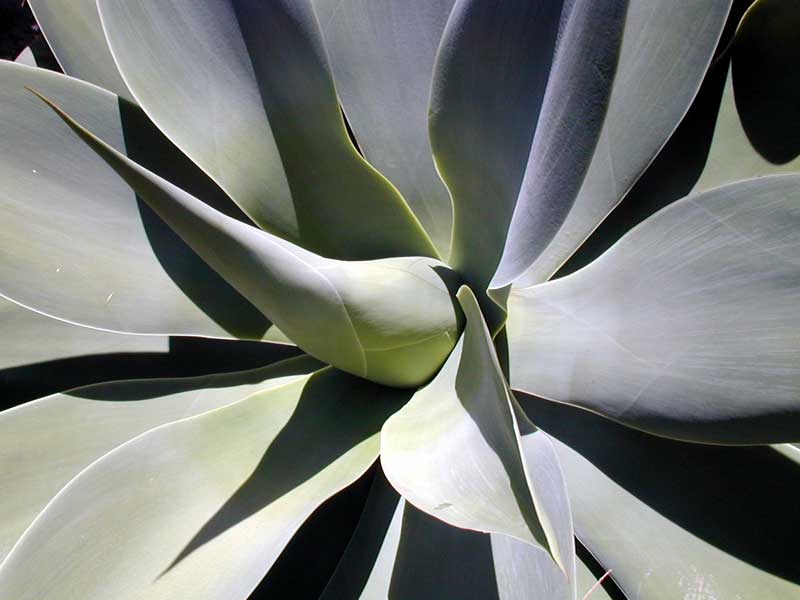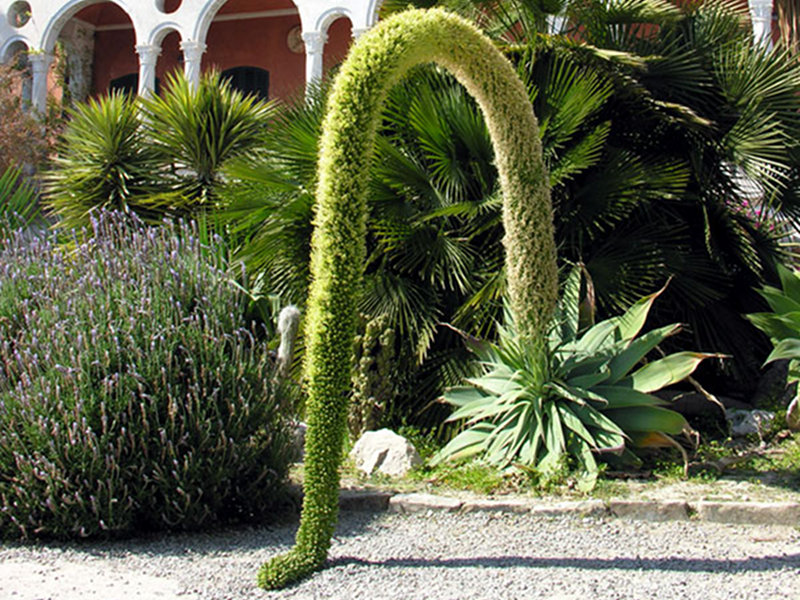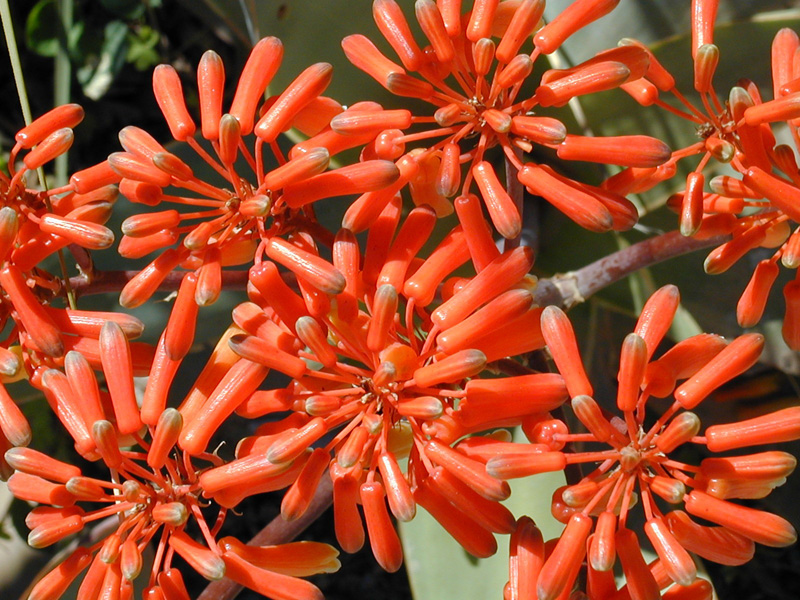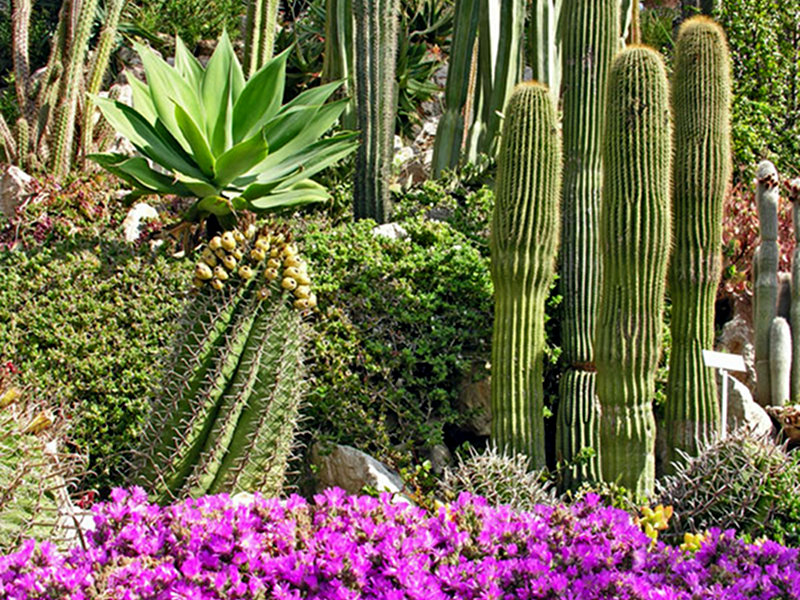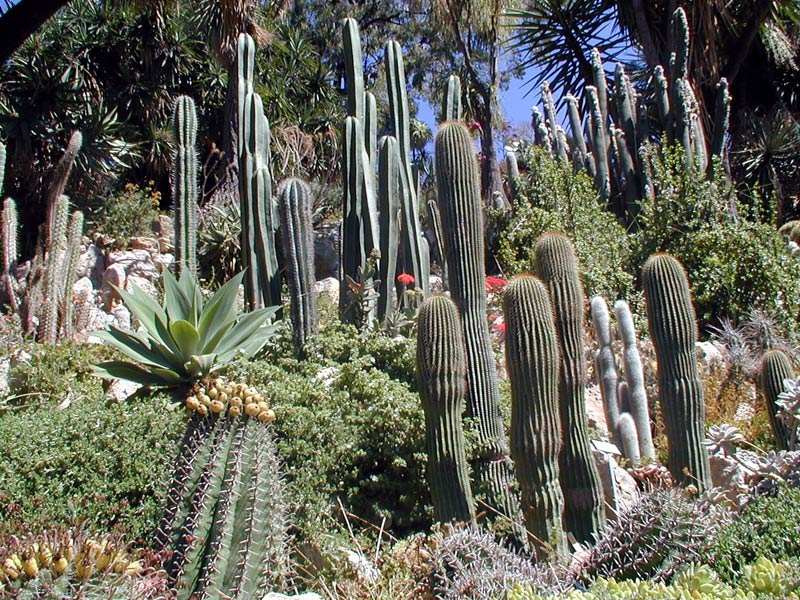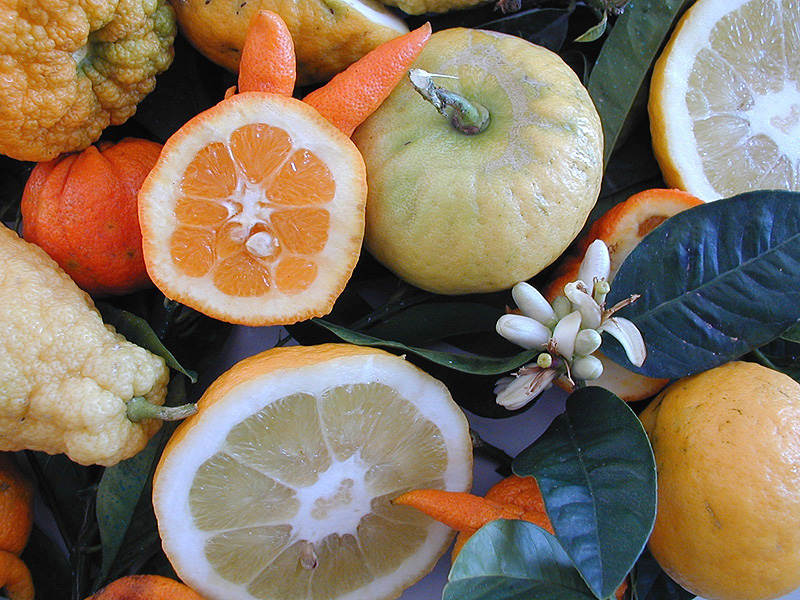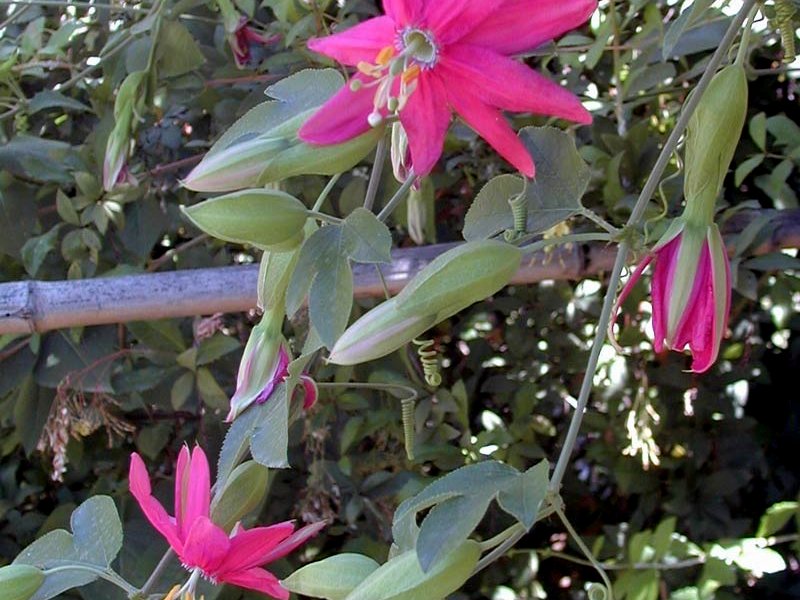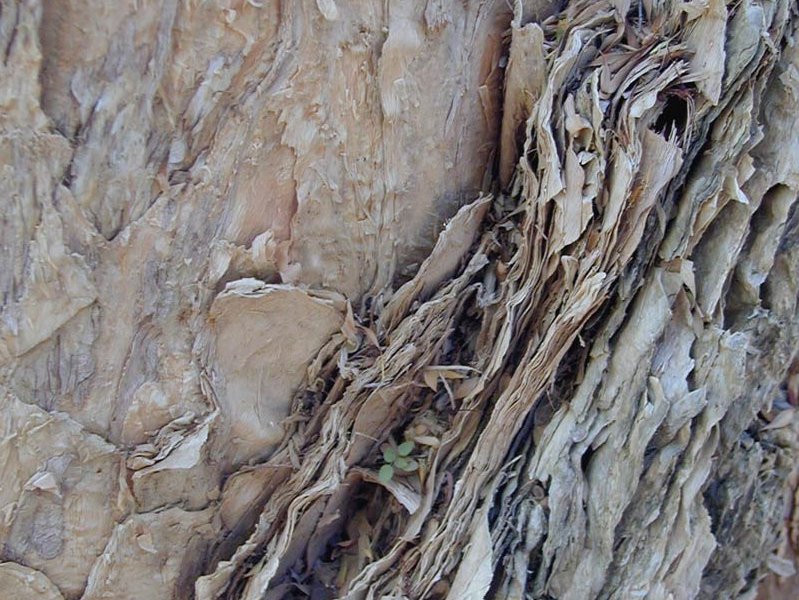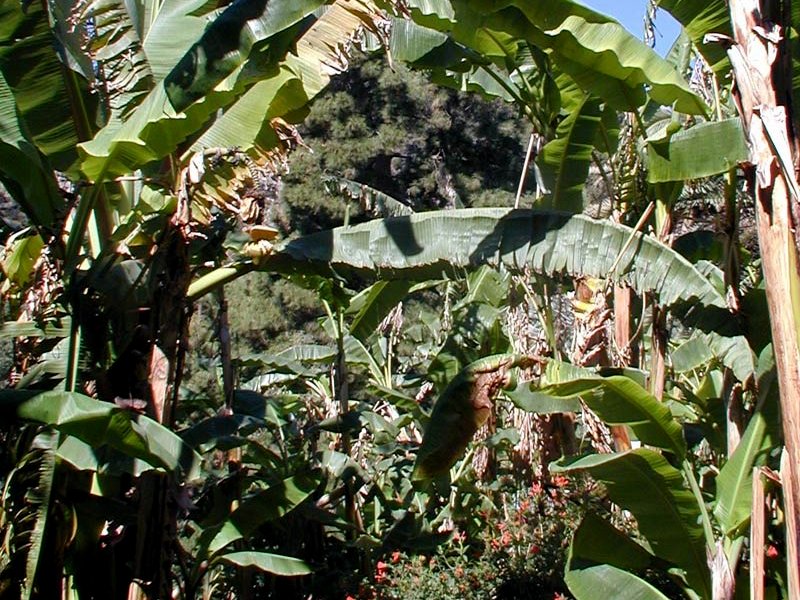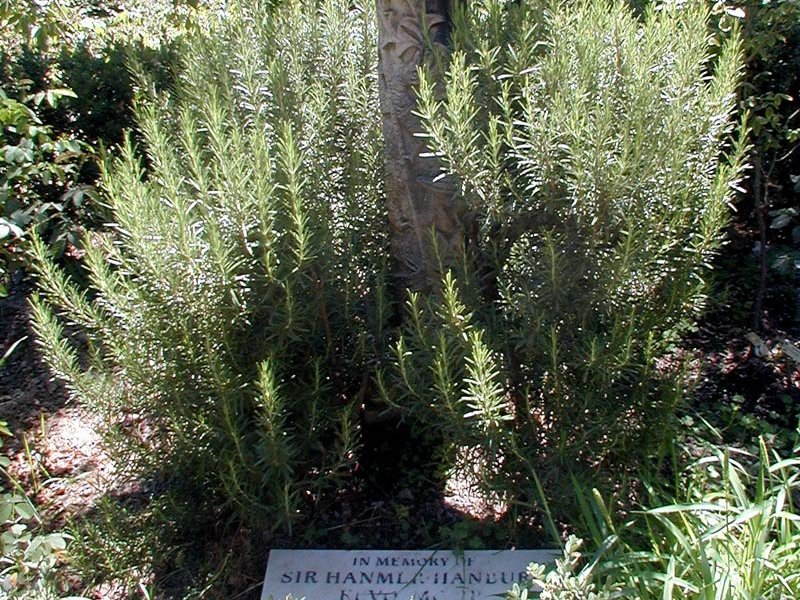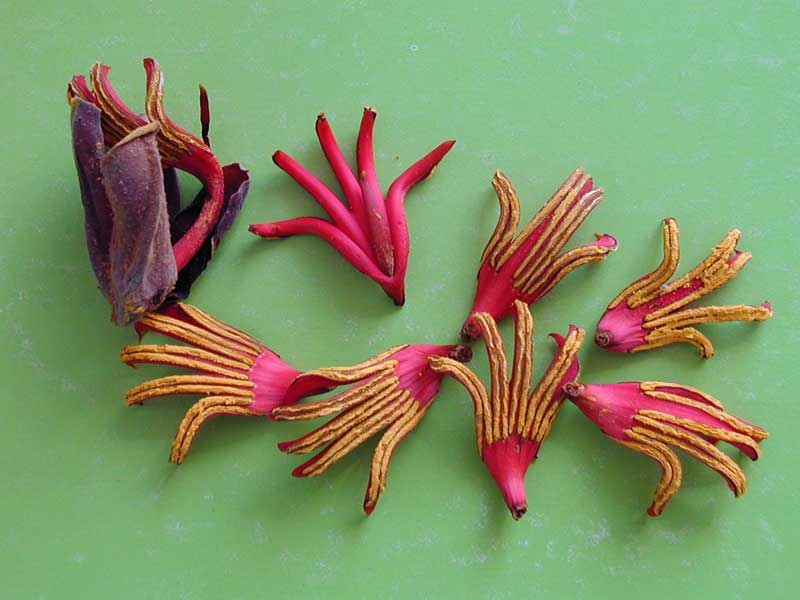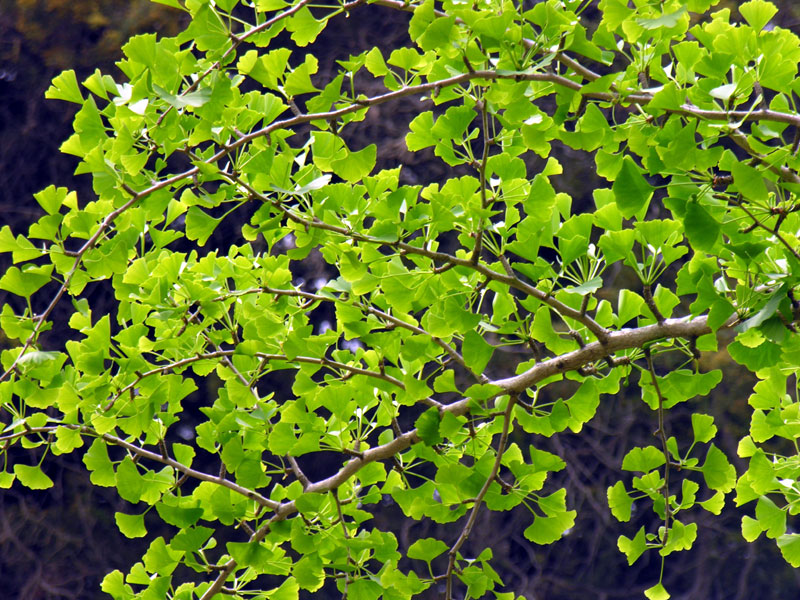Area protetta regionale Giardini Botanici Hanbury
www.giardinihanbury.comPoints of Interest
Agaves
Agaves: Origins, Geographical Distribution, and Ecology
The genus Agave includes more than 200 species coming from America: in
particular from the dry and warm areas of the western United States, of
Mexico, of Central America, and of the Caribbean Basin. Mexico is the
heart of the diversity of the genus, with more than 125 species.
Most of them live in dry environments, from the sea level up to an
altitude of about 2,400m a.s.l.: deserts and dry plains, hills or
coasts. Some species can be found on mountain rocky substrata within
mixed temperate-tropical forests.
Agaves live in regions with temperatures which in summer go regularly
beyond the 40°C and in winter can go behind the -10°C.
Some species present a considerable resistance to cold. The original
agaves of the northern areas of California, Nevada, New Mexico, Arizona
and Utah are the most resistant to low temperatures. Agave utahensis, A. parryi, A. neomexicana and a few others can resist to temperatures lower than -17°C.
Others, like A. palmeri, A. chrysantha, A. lechuguilla,
which come from mountain regions, tolerate temperatures until -10°C
without being seriously damaged. The resistance to frost is higher if
the air is drier and the soil reclaimed.
Agaves: History and Importance of the Collection in Hanbury Botanic Gardens
The first group of agaves was introduced on the Mortola promontory
in June 1868. The collection was enriched in the immediately following
years.
The 1912 catalog lists 114 species; some of them bloomed
for the first time in Europe. After serious losses because of the war
and of the following abandonment, the collection has been recovered.
Nowadays it has been reordered and extended. Every year forty - fifty rosettes related to fifteen - twenty species bloom.
The diversity of agaves (Italian text)
Agaves-Man (Italian text)
Aloes
The Diversity of Aloes
Aloes come from the dry and warm eastern and southern regions of
Africa, from Arabia, and from Socotra Island; they have been widespread
in the Mediterranean area since ancient times.
The genus Aloe
includes more than 180 species and presents a great variety of forms.
Some species are almost lacking in trunk and they have a tuft of basal
leaves; others have an arboreal bearing, with a variously branched
trunk with the tuft of leaves at its top, from which a simple or
branched inflorescence stands out. The leaves are plump, more or less
dentate or thorny along the edges. The flowers are red or yellow, with
six elements gathered in a tube. They bloom from winter to summer.
Aloes are interfertile: many species can hybridize one with the other,
originating individuals with intermediate and gradually shading
morphological features.
In
nature the hybrids are not so frequent; they are more frequent in
gardens where individuals of different species, which in nature are
geographically isolated, are cultivated next one to the other.
Succulent Plants
Succulent plants are suitable to live in dry conditions thanks to the
water they store in some of their organs, in specialized tissues.
Sometimes the leaves have a plump aspect (Crassulaceae, Compositae), more often the trunks transform themselves into real reservoirs (Cactaceae, Euphorbiaceae).
The leaves, also to limit transpiration as much as possible, tend to
disappear or to transform into thorns. The photosynthesis is carried
out by green trunks.
Some strategies give the opportunity to limit the loss of water: thick cuticles and wax-like coverings.
The flowers of Succulent Plants (Italian text)
Succulent plants and evolution convergence (Italian text)
The Spurges
The genus Euphorbia includes about two thousand species
scattered throughout the whole earth surface; many of them are
widespread in the dry and desert tropical and subtropical African
regions.
The spurges present a great morphological diversity: herbs,
shrubs, but also succulent plants. The aspect of the latter reminds the
cacti of the American deserts: columnar or globular trunks, smooth or
tubercolate trunks, the leaves reduced, rarefied or transformed into
thorns.
The flowers are small, wrapped up by glands, gathered in
characteristic inflorescences called "ciazi". Sometimes there are
multicolored and showy leaf bracts making evident this unusual flower
complex.
The spurges are known since ancient times (since 500 BC) for the medicinal, caustic, and poisonous properties of the latex.
The Cacti
They are the succulent plant family most rich in species (over 2,000 divided into 300 genera).
They
come from America, they can be found from Canada to Patagonia, and are
mainly concentrated in the desert and semi-desert areas of the
south-western part of the United States, of Mexico and of the Andes.
Some species have naturalized in the Mediterranean region, in Australia
and Asia.
The trunk can be columnar, cylindric, spherical, articulated in segments (like in Opuntia), creeping or prostrated. The leaves are present only in the genus Pereskia; in most cases they are transformed into thorns.
Some species, like the Saguaro cactus (Carnegiea gigantea), can have huge dimensions (up to 20 meters of height).
Yucca australis
This plant, spectacular for its considerable dimensions, comes from the north-eastern Mexico; Yucca australis is without a doubt among the most imposing arboreal yucca cultivated in
Riviera, where it was introduced in the 19th century with ornamental
aims.
The trunk, widely branched, can reach a circumference of more
than 3 meters and develops in height up to 9-10 meters. The leaves are
stiff, linear, with a filiform edge and a pointed top, 50-60 cm long;
they also persist when they are dry and they form at the ends of the
branches spherical "heads", in the middle of which the hanging
inflorescences develop.
The flowers have a white-cream color and a
bell-shaped corolla (4-5 cm of length) and are perfumed. The
fecundation takes place through Prodoxus yuccasella, a pollinator insect which is not present in Europe.
The Brugmansia Species
According to the historical information, the introduction of Brugmansia
species (in the past) in the Hanbury Gardens dates back to the end of
the 19th century by Thomas Hanbury and his brother Daniel who was a
chemist and was interested in the cultivation of the Solanacee, a
family of great pharmaceutical importance.
In their original regions
(South America) the Brugmansia species were used by the native
population as poison, for medicinal and psychedelic uses and during
religious ceremonies. As a matter of fact, the presence of alkaloids
gives the plants psychotropic and hallucinogen properties. The whole
plant is poisonous.
The flowers, trumpet or bell-shaped, are often hanging. They give off at the sunset a delicate perfume attracting Herse convolvuli; this local butterfly has a very long proboscis and can replace the humming bird in the pollination process.
The Citrus Groves
The citrus trees come from southern Asia, where there is a wild orange
tree, probably the ancestor of both sweet and bitter cultivated orange
trees. The sweet orange tree was cultivated in Europe towards the half
of the 15th century, and it was introduced in the East by the
Portuguese.
The cultivation of citrus trees in Liguria has very
ancient origins: in the 16th century the citrus trees were in Nervi,
Genoa, San Remo, Mentone.
In 1867 Thomas Hanbury found in the estate a considerable number of specimens which he preserved in his own garden.
Currently
in the Hanbury Gardens about twenty species are cultivated - sweet
orange trees, bitter orange trees, lemons, cedars, grapefruits,
bergamots (and others) - many of which are important in the diet, for
cosmetic, pharmaceutical, and ornamental goals.
Cycas, Encephalartos and Zamia... Real Living Fossils!
It is a group of very ancient origins, currently including one hundred
of species, which in the Mesozoic Age (from 200 to 100 million years
ago) represented about the two fifths of the terrestrial flora.
In
the roots of these plants particular blue algae live in symbiosis: they
are able to fix the atmospheric nitrogen and to convert it in mixtures
available for the plants.
The aspect is similar to the aspect of
the palms: in some species the trunk develops in height (up to 20m),
in others is shortened and has at its top a tuft of leaves.
You can distinguish individuals with female apparatuses (with ovules
which are rather evident) and individuals with male apparatuses looking
like erected cones.
The Passion Flowers Collection
The genus Passiflora includes more than 465 species, having
almost all a creeping and liana-like behavior. The hybrid species are
several, thanks to the high number of species which can be crossed one
with the other.
Most part of the passion flowers come from
central-southern America, and in particular from large tropical and
subtropical areas going from the Andes chain up to the coasts of the
Atlantic Ocean. Some species come from North America (USA), Australia
or Asia. The introduction in Europe took place during the first half of
the 17th century.
The Collection of the Botanic Gardens Hanbury,
dedicated to the prematurely died Paola Gastaldo - professor of
Pharmaceutical Botany at the University of Genova - currently includes
about forty different passion flowers, all cultivated in earth.
The 'Australian Forest'
The "Australian Forest" is characterized by the presence of big specimens of the genera Eucalyptus, Melaleuca and Brachychiton. Moreover, there are plants belonging to the genera Acacia, Callistemon, Grevillea and Tristania.
The
poverty of the undergrowth is rather evident, and is given to the
presence in the soil of toxic substances secreted by the roots of many
trees, above all by eucalypti: moreover, the latter are among the most
rapidly developing and the biggest trees in the Garden.
The genus Eucalyptus includes about 600 species of trees and shrubs. The eucalypti all come exclusively from Australia.
Some species are well-adapted and widespread in the Mediterranean region, like E. globulus and E. camaldulensis; others are very rare, like E. citriodora, whose leaves smell of lemon.
Among the trees of the Australian area there are some specimens of Melaleuca styphelioides (Myrtaceae),
coming from south-western Australia (New South Wales). Its bark is very
particular, since it comes off in very thin layers: as a matter of
fact, it was used in the past by the native population as paper.
Brachychiton discolor is a tree coming from Australia, cultivated in the parks and in the
gardens as an ornamental plant. The blooming begins in July and
continues all the summer long. The flowers, rose and bell-shaped, are
unisexual. The male flowers remain open on the branches for 1 or 2
days, then they fall. At the foot of the tree you will find a flower
bed. The female flowers remain open longer on the plant and, if
fecundated, they produce woody fruits opening only when the ripening
process is complete.
The Exotic Orchard
In the "Piana", in the areas near the citrus groves, there are plants
of different origin which are able to produce tasty fruits in our
climate.
Next to plants which have become common in our diet like Musa x paradisiaca (banana tree), Cydonia sinensis (quince tree), Persea americana (avocados), there are less common specimens like Acca sellowiana (Feijoa) from South America, Eugenia guabiju (Eugenia) from Argentina, Carica quercifolia from South America, Psidium cattleyanum (Psidium) from Southern Brazil, Macadamia ternifolia from Australia, Casimiroa edulis from Mexico and Guatemala, Hovenia dulcis from the Far East, Corynocarpus laevigatus from New Zealand.
The 'Giardinetti'
The "Giardinetti" have been considered by the family Hanbury as the heart of the Gardens.
Here
various members of the family are recalled: among them Sir Hanmer
Hanbury (1916 - 1993), whose tombstone is surrounded by rosemary, a
plant which for English people means the memory.
They are three monothematic terraces.
In the upper and lower little gardens there are ancient peonies cultivars; the central little garden houses roses with delicate perfumes: French roses, damask roses, Bourbon roses.
The roses bloom form March to May; the peonies, from the white ones to the pale rose, to the intense rose, bloom in April.
The Sage Collection
The genus Sage, with about 900 species, is the most important genus of the Lamiaceae family.
More than a half of the species is exclusive to the American continent,
from the dry environments of California and Mexico to the tropical
forests. The others are scattered throughout Europe, Asia, and Africa,
from the dry and sunny environments to the mountain fresh and shady
woods.
Some sages are herbaceous with leaves gathered in basal
rosettes, others are shrubs, from a few centimeters of height to a
couple of meters.
Several sage species have been used since ancient times as medicinal plants.
Chiranthodendron pentadactylon
Chiranthodendron pentadactylon is the name given to this plant coming from central America. The
denomination refers to the curious shape of the stamens which are
partially united and form a red small hand with hooked fingers.
For
this feature, the tree is considered sacred, and the native population
would gather its flowers for the religious ceremonies.
The plant was
considered to be extinct; only in 1787 a unique specimen was found in
Mexico. Almost after a century in Guatemala whole forests of it were
discovered.
The tree you can find along the route is thirty years old and regularly blooms every year between May and June.
It has been seriously damaged by the hard frost during the winter of 1985 and 1986 and has begun to bloom only five years later.
Ginkgo biloba
A very ancient and frequently cultivated plant, it is not certainly
known at its spontaneous state. It is probably a plant coming from
China.
It is common above all in Japan, where its fruits are also eaten after fermentation.
The original pronunciation of the Japanese name of the plant was known by Linnaeus (Ginkyo), however it was transcribed Ginkgo for a banal misprint.



